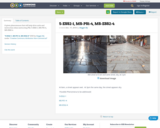
A given phenomenon that will help drive units and instruction when instructing PEs: 5-ESS2-1, MS-PS1-4, MS-ESS2-4
- Subject:
- Applied Science
- Environmental Science
- Physical Science
- Material Type:
- Teaching/Learning Strategy
- Date Added:
- 12/14/2018

A given phenomenon that will help drive units and instruction when instructing PEs: 5-ESS2-1, MS-PS1-4, MS-ESS2-4
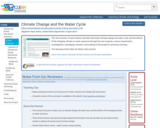
This unit consists of seven distinct activities that teach climate change, the water cycle, and the effects of the changing climate on water resources through the use of games, science experiments, investigations, role-playing, research, and creating a final project to showcase learning.
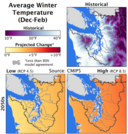
By the end of this course participants will…Understand how local phenomena interact with the Next Generation Science Standards, climate change, ecosystems, and people in a community.Experience how local phenomena and field investigations can build scientific understanding.
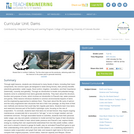
Through eight lessons, students are introduced to many facets of dams, including their basic components, the common types (all designed to resist strong forces), their primary benefits (electricity generation, water supply, flood control, irrigation, recreation), and their importance (historically, currently and globally). Through an introduction to kinetic and potential energy, students come to understand how dams generate electricity. They learn about the structure, function and purpose of locks, which involves an introduction to Pascal's law, water pressure and gravity. Other lessons introduce students to common environmental impacts of dams and the engineering approaches to address them. They learn about the life cycle of salmon and the many engineered dam structures that aid in their river passage, as they think of their own methods and devices that could help fish migrate past dams. Students learn how dams and reservoirs become part of the Earth's hydrologic cycle, focusing on the role of evaporation. To conclude, students learn that dams do not last forever; they require ongoing maintenance, occasionally fail or succumb to "old age," or are no longer needed, and are sometimes removed. Through associated hands-on activities, students track their personal water usage; use clay and plastic containers to model and test four types of dam structures; use paper cups and water to learn about water pressure and Pascal's Law; explore kinetic energy by creating their own experimental waterwheel from two-liter plastic bottles; collect and count a stream's insects to gauge its health; play an animated PowerPoint game to quiz their understanding of the salmon life cycle and fish ladders; run a weeklong experiment to measure water evaporation and graph their data; and research eight dams to find out and compare their original purposes, current status, reservoir capacity and lifespan. Woven throughout the unit is a continuing hypothetical scenario in which students act as consulting engineers with a Splash Engineering firm, assisting Thirsty County in designing a dam for Birdseye River.
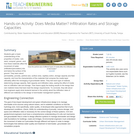
Students gain a basic understanding of the properties of media soil, sand, compost, gravel and how these materials affect the movement of water (infiltration/percolation) into and below the surface of the ground. They learn about permeability, porosity, particle size, surface area, capillary action, storage capacity and field capacity, and how the characteristics of the materials that compose the media layer ultimately affect the recharging of groundwater tables. They test each type of material, determining storage capacity, field capacity and infiltration rates, seeing the effect of media size on infiltration rate and storage. Then teams apply the testing results to the design their own material mixes that best meet the design requirements. To conclude, they talk about how engineers apply what students learned in the activity about the infiltration rates of different soil materials to the design of stormwater management systems.
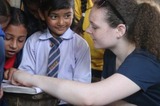
This book is intended for use by future teachers, written from the perspective of students who have taken Science Methods II. The student authors gathered and created resources to help prospective elementary cience teachers better understand science and feel confident in your abilities as a future teacher.
This book is divided into five parts which align with the Science Methods II course:
Physics
Space Science
Earth Science
Climate Science
Course Materials and Pedagogy
Within each part, the material is broken down into smaller chapters. Here you will find written explanations, video links, glossary terms, key takeaways, and practice quizzes to help you understand the material. This book is designed to be a flexible resource; use it as much or as little as you need throughout the course.

In this unit, students wonder about the physical drivers of ocean movement, explore density differences, and take a look at some tiny creatures who struggle to keep their place in the water column in the midst of all that ocean motion.
Each unit of the Explore the Salish Sea curriculum contains a detailed unit plan, a slideshow, student journal, and assessments. All elements are adaptable and can be tailored to your local community.
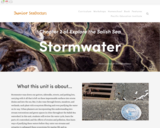
In Unit 2 of the Explore the Salish Sea curriculum, students will review the water cycle, learn the parts of a watershed, and the effects of erosion and pollution, then learn ways of purifying these waters before they enter our streams and estuaries to safeguard these ecosystems for marine life and us.
Each unit in this series contains a detailed unit plan, a slideshow, student journal, and assessments. All elements are adaptable and can be tailored to your local community.
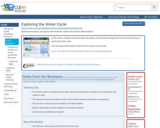
In this lesson, students will learn about the water cycle and how energy from the sun and the force of gravity drive this cycle.

Between 70 and 75% of the Earth's surface is covered with water and there exists still more water in the atmosphere and underground in aquifers. In this lesson, students learn about water bodies on the planet Earth and their various uses and qualities. They will learn about several ways that engineers are working to maintain and conserve water sources. They will also think about their role in water conservation.

In this activity, students compare two photographs (with time spans of 30-100 years between photos) of specific Alaskan glaciers to observe how glaciers have changed over the time interval. Activity is a good kickoff for learning about glaciology - how and why glaciers form, grow and shrink, and their relation to climate change.

Students are presented with a guide to rain garden construction in an activity that culminates the unit and pulls together what they have learned and prepared in materials during the three previous associated activities. They learn about the four vertical zones that make up a typical rain garden with the purpose to cultivate natural infiltration of stormwater. Student groups create personal rain gardens planted with native species that can be installed on the school campus, within the surrounding community, or at students' homes to provide a green infrastructure and low-impact development technology solution for areas with poor drainage that often flood during storm events.
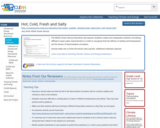
The NOAA Ocean Service Education lab requires students create and manipulate solutions simulating different ocean water characteristics in order to recognize that the effects of salinity and temperature are the drivers of thermohaline circulation.
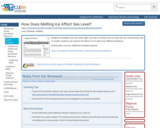
Students investigate how sea levels might rise when ice sheets and ice caps melt. By constructing a pair of models, students can observe the effects of ice melt in two different situations.
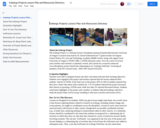
The Icebergs Project is a National Science Foundation sponsored partnership between University of Oregon’s research team lead by Dr. David Sutherland and 7th grade teachers for Eugene School District 4J’s Arts and Technology Academy Middle School, along with support from University of Oregon’s STEM CORE, a STEM education center. Over the course of several years teachers and scientists co-planned, revised, and carried out a research-connected cross-disciplinary project-based unit culminating in an “Icebergs Field Day” involving all members of the PI’s research team. Ultimately two separate week-long units were designed, with only one implemented each year.

The University of Iowa Center for Global and Regional Environmental Research and College of Education teamed up to develop free eighth grade science curricula on land use and climate science, in response to Iowa’s grade level alignment of the middle school Next Generation Science Standards.
Primary author Dr. Ted Neal, clinical associate professor of science education, led a team of graduate and pre-service teaching students and CGRER scientists to develop the material. They grouped standards, resources and lesson material into six bundles, each designed to engage Iowa’s middle schoolers with local data and information on relevant topics like athletic concussions and agriculture.
These lessons are built on NGSS principles and put learning in the students’ hands with hands-on activities for groups and individuals. Kids will have ample opportunity to get curious, generate questions and lead themselves to answers.
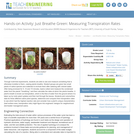
Through multi-trial experiments, students are able to see and measure something that is otherwise invisible to them seeing plants breathe. Student groups are given two small plants of native species and materials to enclose them after watering with colored water. After being enclosed for 5, 10 and 15 minutes, teams collect and measure the condensed water from the plants' "breathing," and then calculate the rates at which the plants breathe. A plant's breath is known as transpiration, which is the flow of water from the ground where it is taken up by roots (plant uptake) and then lost through the leaves. Students plot volume/time data for three different native plant species, determine and compare their transpiration rates to see which had the highest reaction rate and consider how a plant's unique characteristics (leaf surface area, transpiration rate) might figure into engineers' designs for neighborhood stormwater management plans.

Astronauts cannot just flip on a faucet when they want to wash their hands. Learn about water conservation on the International Space Station.
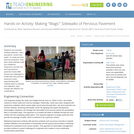
Students use everyday building materials sand, pea gravel, cement and water to create and test pervious pavement. They learn what materials make up a traditional, impervious concrete mix and how pervious pavement mixes differ. Groups are challenged to create their own pervious pavement mixes, experimenting with material ratios to evaluate how infiltration rates change with different mix combinations.
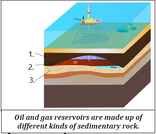
Fossil Fuel Formation & Use